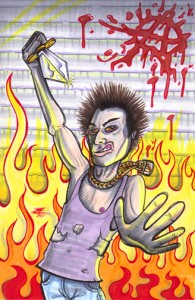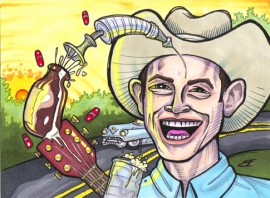John Simon Ritchie’s career with the Sex Pistols only lasted nine months, but through the miraculous power of media spin he was transfigured into the original punk rock martyr—Sid Vicious, dead at 21. Smeared across pop culture’s porcelain temple on February 2, 1979, he is immortalized in black leather, oily spiked hair, and dripping bodily fluids.
Next to him, rendered in blood-spattered stained glass, resides the junk-adled groupie who dominated him in life and defined him in death—”Nauseating” Nancy Spungen, dead at 20. Sid and Nancy. For three generations, vast segments of our disaffected youth have followed in their staggering footsteps, slamming syringe plungers to a rock n’ roll soundtrack and smashing up their little corners of an unbearably boring society. Oi! Oi!
The Sex Pistols left an indelible stamp upon the soul of punk rock. The genre’s grim sarcasm doesn’t gnaw much harder than vocalist Johnny Rotten’s “Bodies” or “No Feelings.” Their one true album, Never Mind the Bullocks, Here’s the Sex Pistols, is an enduring classic of cocky rebellion—for which Sid Vicious deserves no real credit, except for his sneering face. The bass guitar was, quite literally, a mere prop for his nihilistic persona.
The only song that Sid is remembered for is a garbled rendition of Frank Sinatra’s “My Way.” This satanic dirge pays homage to the unrepentant ego at death’s door, and Vicious gave it a convincing go. The irony is that between Nancy’s nagging and the Sex Pistols’ manipulative manager, Malcolm McLaren, Sid Vicious did almost nothing his own way.
It’s not that Vicious’ image was a total fabrication so much as carefully cut fodder for the hype machine. Sid was raised by a junkie mother in the dregs of working class London, a scrawny misfit whose utter defiance was bullied into him by neighborhood toughs. He was born with a photogenic chip on his shoulder, and after his first gig with the Sex Pistols in April of 1977, Malcolm McLaren made sure the bulbs kept flashing.
While friends remember Sid as a scrappy little wiener, popular mythology emphasizes his assault on NME journalist Nick Kent with a motorcycle chain, his reputed mugging of an old lady at knife point, and the Texas crowd member who got his dome cracked by Sid’s bass guitar. Every snot glob dangling from Sid’s nostril, every self-induced laceration gushing over his torso, and every needle jammed into his arm was another photo op. Angsty teenagers still tack the posters up on their walls, many of which feature Nancy’s scowling, yet cherubic face beside him.
By all accounts—even her own mother’s—Nancy Spungen was a neurotic pseudo-nymph with a screeching voice and a sweet tooth for brown sugar. Of course, she had her shining qualities too. Unfortunately, no one remembers what they were. Leaving her comfy Jewish home at age fifteen, Nancy chased the dragon to New York City, where she took up the world’s oldest profession. She promptly wormed her way into the hip cliques of CBGB’s thriving punk scene, who quickly found her annoying and pushed her back out.
Rejected by the outcasts, Nancy followed an oozing trail of punk rock cock all the way to London, intent on nailing the New York Dolls’ drummer. She wound up with punk’s hottest poster boy instead. Jaded beyond their years, each found something new in the other. For all of his bravado, Sid was still fresh meat between the sheets, and Nancy had never been with someone who actually enjoyed her company before. He became a man and she became a lady as the cameras clicked on their heels.
It’s unclear whether Sid ever learned to play his instrument, but it was his energetic stage presence that counted. The musicianship problem was solved by turning down his bass and putting a session player backstage. After blowing England apart, the Sex Pistols hopped across the pond for an American tour in January 1978. Even without Nancy, it was a disaster. Tour highlights include Sid overdosing, going into a dope coma days later, and then carving “GIMME A FIX” into his torso when forced to detox. During their final, lackluster performance in San Francisco, Johnny Rotten growled, “Ever get the feeling you’ve been cheated?” and stormed offstage. The Sex Pistols broke up soon after. Nancy stepped in to manage Sid’s solo career, which lasted all of ten minutes. By late 1978, Sid and Nancy were slumming around New York on royalties, where they would soon perform their gutter rendition of Romeo and Juliet.
No one doubts Sid and Nancy’s true love for one another. Beneath the manic consumption and mutual violence, there was an undeniable sweetness. Those black eyes and busted smoochers? They was jus’ love pats, mate. The throbbing, abscessed puncture wounds lining their veins? Relationships are built on intensely shared experiences, right? Through highs and lows, uppers and downers, black spikes, bleached bangs, and bloody leather—these crazy kids were made for each other.
So why did Sid stab her to death and then jab a fatal dose of smack a few months later? Well, it’s complicated. First off, no one really knows who killed Nancy. On the morning of October 12, in Room 100 of the grimy Chelsea Hotel, Nancy was found in her undies on the bathroom floor, having bled to death from a single knife wound beneath her navel.
Sid was the only person there when police arrived. In fact, he was the one who called them—after he went out to score some dope, anyway. The hotel scene was shady, the official statements were incoherent, and possible motives abound. If Nancy was anywhere near as shrill as her portrayal in the 1986 film, Sid and Nancy, I wouldn’t put it past Mohandas Gandhi to stick a knife in her gut, if only to shut her the fuck up.
In the beginning, everyone thought Sid did it. He told the cops as much, stating: “I stabbed her, but I didn’t mean to kill her.” Then later, he insisted he didn’t do it. He had eaten handfuls of Tuinol—a potent barbiturate—and passed out. In the end, he didn’t remember what happened.
According to interviews in the 2009 documentary Who Killed Nancy?, a third party was with the couple that night. Sid had recently received $25,000 for his recording of “My Way,” and there was cash all over their hotel room. When the cops arrived, the money was gone. Perhaps the mystery visitor killed Nancy and snatched up the loot as Sid snored.
To add another candlestick to Colonel Mustard’s drawing room, Sid’s mother claimed to have found a note in Sid’s jacket after he died, which described a suicide pact between him and Nancy. This raises the possibility that Nancy stabbed herself—presumably because she could no longer stand the sound of her own voice.
Whatever the case, Sid was charged with second degree murder and the judge set bail at $50,000. McLaren paid the money through Virgin Records, and Sid hit the streets. Within a week he was in Bellevue Hospital with a pair of slit wrists. His mother flew in to console him—with some soul-soothing smack—and McLaren made up t-shirts to sell in his London boutique that read: “I’m Alive. She’s Dead. I’m Yours.”
With his badboy image now solidified by a murder rap, Sid was swimming in New York floozies. His ego must have been on fire the night he assaulted Patti Smith’s brother. Sid was chatting up Todd Smith’s girlfriend at a Skafish show, when he decided to pinch her. Todd protested, so Vicious broke a Heineken bottle and proceeded to stab him in the face. Sid spent 55 days in Riker’s Island Prison before he was released on February 1, on another $50,000 bond.
Who knows what happened in those 55 days behind bars. Perhaps Sid did some deep soul-searching. Maybe he realized the life-shattering implications of an impending murder conviction. It’s also possible that larger, more formidible predators took Sid’s “punk” identification to its logical conclusion and did their own brutally deep searching of his soul. After 55 days of that, who wouldn’t seek some hardcore relief?
Whatever happened, Sid made the most of his first night of freedom, enjoying a spaghetti dinner with family and friends at his new girlfriend’s Greenwich Village apartment. Heroin users say that spiking a good hit is like returning to the comfort of the womb. How appropriate then that the perpetually infantile Sid Vicious got his last shot from his mother that evening. Lab results suggest that her love was as pure as the driven snow. Sid was pronounced dead on February 2, 1979 from “acute intravenous narcotism.” The groundhog must not have seen his own shadow that day, because Sid’s mother claimed to have spread his ashes over Nancy’s snow-covered grave. She went on to kill herself with an overdose in 1996. Never trust a junkie.
However tragic, Sid’s passing provided powerful inspiration for the music world. Nearly two years later—the day before John Lennon’s assassination, in fact—sado-punk Darby Crash paid homage to his hero with a fatal spoonful. In ’93, scumfuck rocker GG Allin went out the same way, breaking his vow to blow himself up onstage. The next year, death star Kurt Cobain kissed the hot end of a shotgun. He and his wife Courtney Love consciously fashioned themselves after Sid and Nancy, though Kurt was arguably late on the draw. (Coincidentally, both Kurt and Sid killed themselves after touring with the Buzzcocks, as did Joy Division’s rising star, Ian Curtis. Perhaps they should have called themselves the Buzzkills.) Most importantly, Sid Vicious’ decadent icon provides fashionable validation for thousands of unsung throw-away kids who shuffle off this mortal coil year after year, with a needle in one arm and a blue middle finger thrust to the world.
© 2011 Joseph Allen

